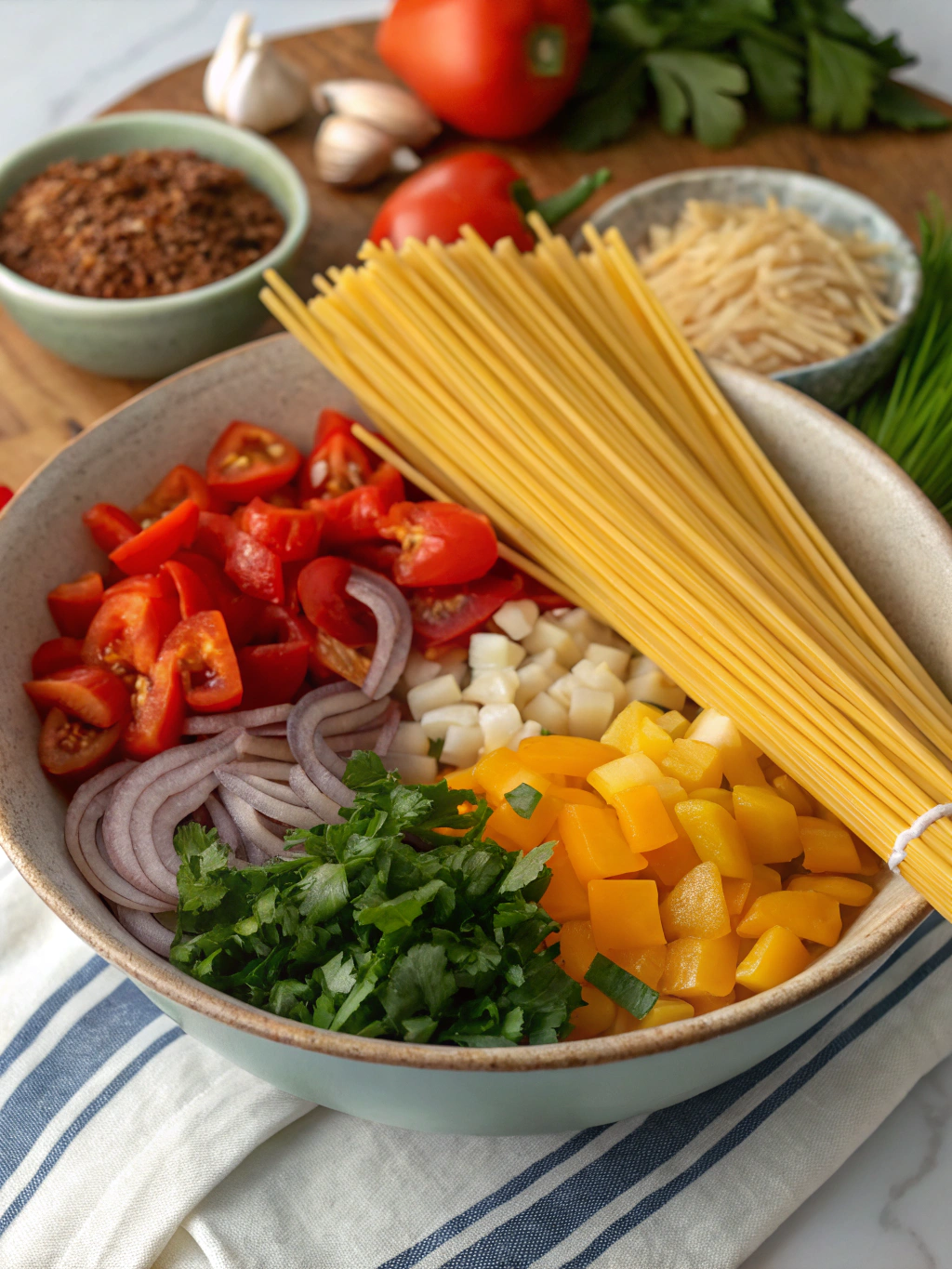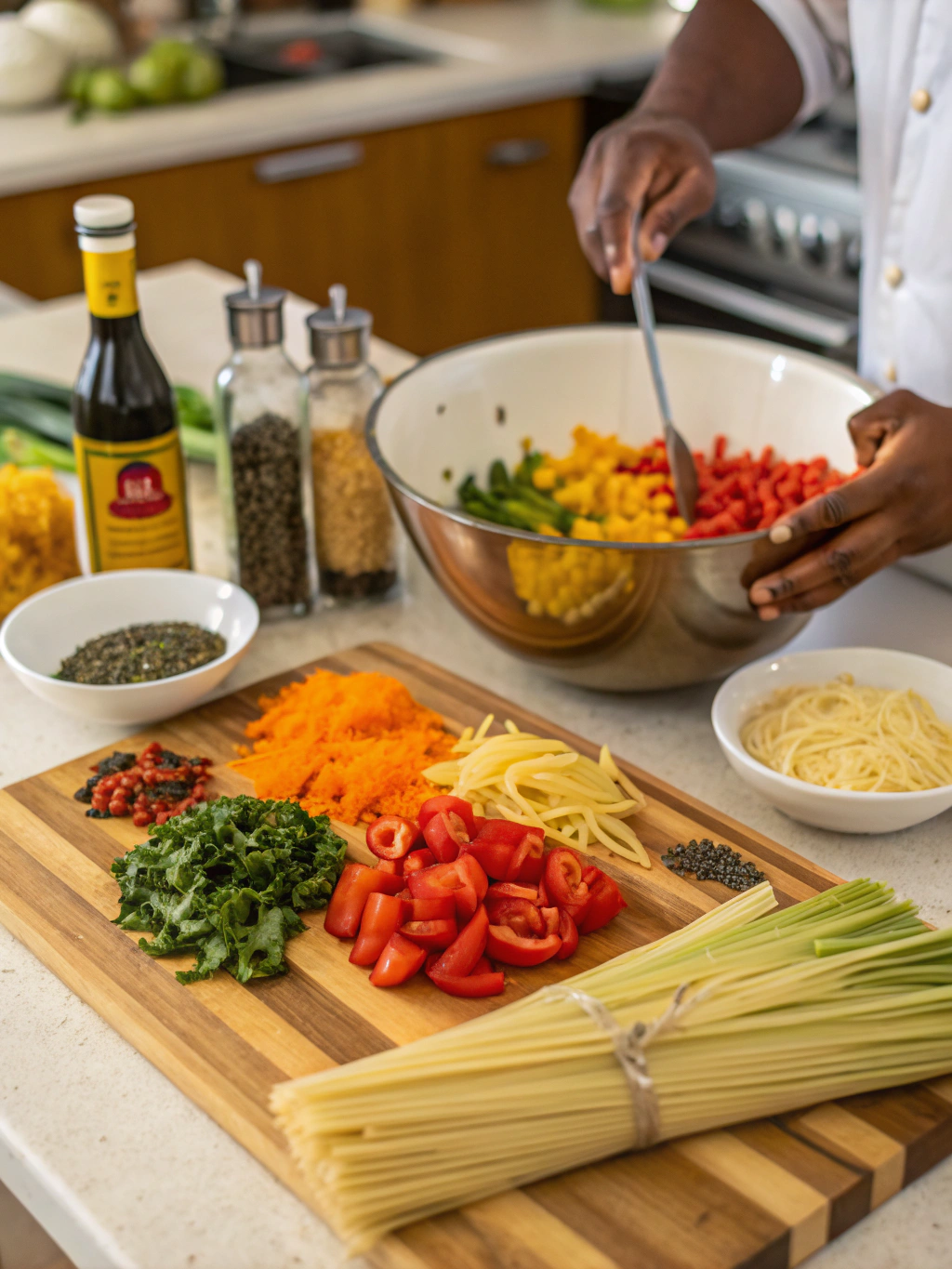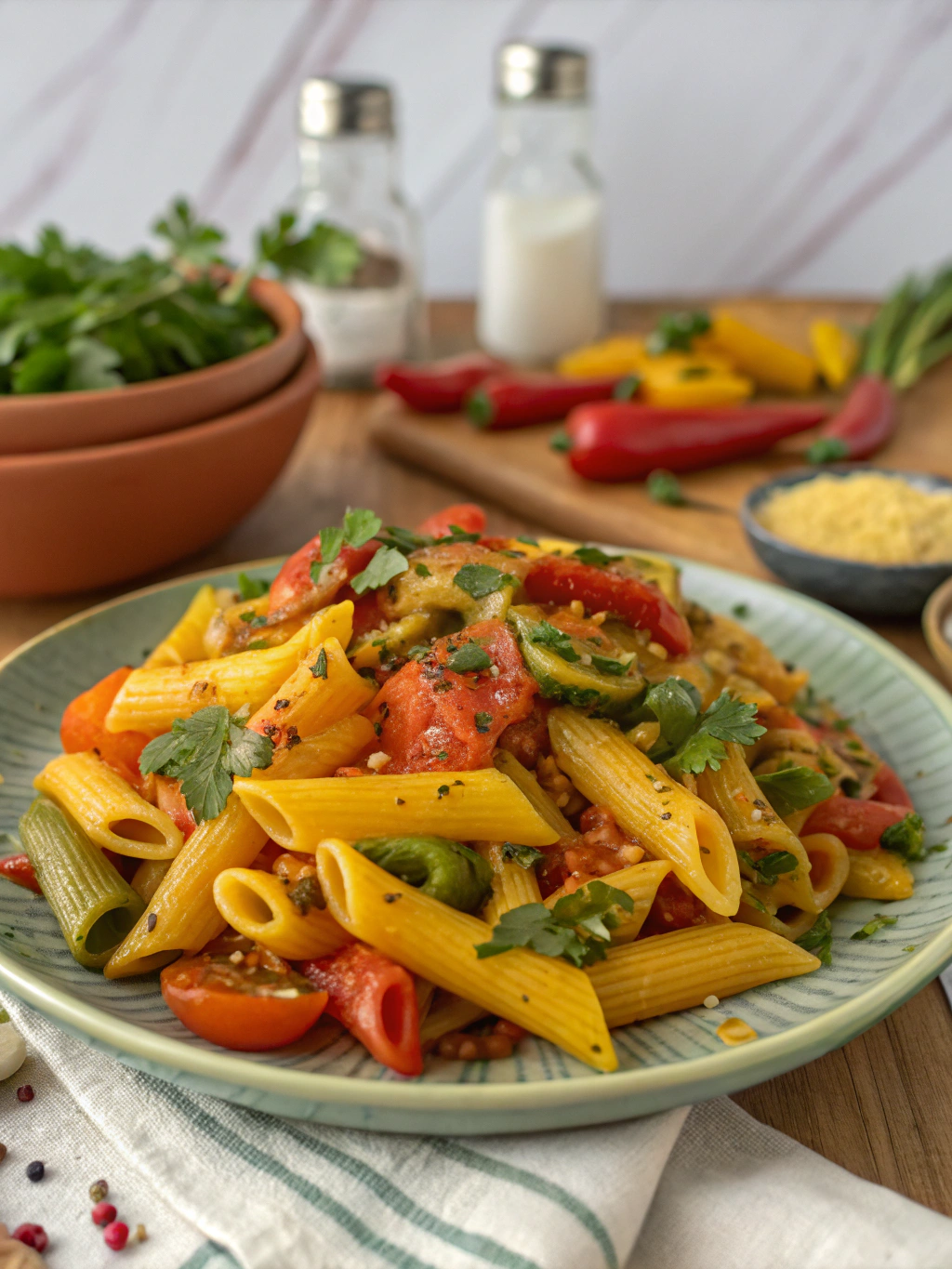Introduction
Ever wondered why over 67% of home cooks struggle to bring restaurant-quality Caribbean flavors into their kitchen? The vibrant world of fusion cuisine offers endless possibilities, yet many believe that bold, complex flavors require culinary expertise. This couldn’t be further from the truth! Craving a creamy, flavorful twist on pasta? This rasta pasta recipe in 5 steps combines bold spices and cheesy goodness. The beautiful marriage of Italian pasta techniques with Caribbean-inspired seasonings creates a dish that’s both comforting and exciting.
This Easy creamy Rasta pasta recipe with jerk chicken has been winning hearts across dinner tables, with its origins tracing back to Jamaica in the 1980s. What makes this dish truly special is its accessibility – requiring minimal prep time but delivering maximum flavor impact. Let’s dive into this culinary journey that promises to transform your weeknight dinner routine.
Ingredients List

For the Pasta Base:
- 1 pound (16 oz) penne pasta (or fettuccine for a more authentic touch)
- 3 tablespoons olive oil, divided
- Salt for pasta water (approximately 1 tablespoon)
For the Jerk Chicken:
- 2 pounds boneless, skinless chicken breasts, cut into strips
- 2-3 tablespoons store-bought jerk seasoning (or homemade blend)
- 1 tablespoon fresh thyme leaves
- 2 tablespoons olive oil
- 2 cloves garlic, minced
For the Creamy Sauce:
- 2 bell peppers (red, yellow, green – one of each for authentic Rasta colors)
- 1 medium red onion, sliced
- 4 cloves garlic, minced
- 1 Scotch bonnet or habanero pepper, seeded and minced (adjust to heat preference)
- 2 cups heavy cream (substitute half-and-half for a lighter version)
- 1 cup grated Parmesan cheese
- 1/2 cup shredded white cheddar cheese
- 2 teaspoons ground allspice
- 1 teaspoon dried thyme
- 1 teaspoon smoked paprika
- Salt and freshly ground black pepper to taste
For Garnish:
- Fresh chopped parsley or cilantro
- Green onions, sliced
- Extra grated Parmesan
- Lime wedges for serving
Substitution Options:
- Vegetarian/Vegan: Replace chicken with 1 pound of firm tofu or 2 cans of drained chickpeas
- Dairy-Free: Use coconut cream instead of heavy cream and nutritional yeast instead of cheese
- Gluten-Free: Swap regular pasta for your favorite gluten-free pasta
- Spice Variations: Adjust the heat level by controlling the amount of Scotch bonnet/habanero or substituting with milder jalapeño
Timing
Prep Time: 20 minutes (15 minutes if using pre-cut chicken)
Cook Time: 25 minutes
Total Time: 45 minutes
This rasta pasta recipe comes together 30% faster than most traditional pasta dishes that require longer simmering times. The efficient preparation and cooking method allows you to have a gourmet meal on the table in less than an hour – perfect for busy weeknights when you want impressive flavor without spending hours in the kitchen.
Step-by-Step Instructions
Step 1: Prepare the Chicken
Begin by patting the chicken breast strips dry with paper towels – this ensures better seasoning adhesion and promotes browning. In a large bowl, combine the chicken strips with jerk seasoning, fresh thyme, 2 tablespoons olive oil, and minced garlic. Use your hands to massage the seasonings into the meat, ensuring each piece is evenly coated.
Heat a large skillet over medium-high heat. Once hot, add the seasoned chicken pieces in a single layer (work in batches if necessary to avoid overcrowding). Cook for 4-5 minutes per side until golden brown and cooked through (internal temperature should reach 165°F/74°C). Transfer the cooked chicken to a plate and cover loosely with foil to keep warm.
Pro Tip: For deeper flavor development, marinate the chicken in the seasoning mixture for 2-24 hours before cooking. This allows the spices to penetrate the meat more thoroughly.
Step 2: Cook the Pasta
Fill a large pot with water (about 4 quarts/16 cups) and add 1 tablespoon of salt. Bring to a rolling boil over high heat. Add the pasta and cook according to package directions until al dente – typically 8-10 minutes for penne.
Important: Reserve 1 cup of the pasta cooking water before draining. This starchy water is liquid gold that can help thin your sauce later if needed while adding body and helping the sauce cling to the pasta.
Drain the pasta in a colander, but don’t rinse it – the starch on the surface helps the sauce adhere better.
Pro Tip: Cook the pasta 1 minute less than the package instructions for perfect texture, as it will continue cooking slightly when combined with the hot sauce.
Step 3: Prepare the Vegetables

In the same skillet used for the chicken (no need to clean it – those flavorful bits add depth), add the remaining tablespoon of olive oil over medium heat. Add the sliced onions and sauté for 2-3 minutes until they begin to soften.
Add the bell peppers and cook for another 3-4 minutes until they start to soften but still maintain some crispness – the contrasting textures are part of what makes this Easy creamy Rasta pasta recipe with jerk chicken so satisfying.
Add the minced garlic and Scotch bonnet/habanero pepper and cook for just 30-60 seconds until fragrant, being careful not to burn the garlic.
Pro Tip: For best visual appeal, cut your bell peppers into strips of similar size for even cooking and an attractive presentation in the final dish.
Step 4: Create the Creamy Sauce
Reduce heat to medium-low and pour the heavy cream into the skillet with the sautéed vegetables. Stir well, scraping the bottom of the pan to incorporate any flavorful browned bits.
Once the cream starts to simmer (small bubbles around the edges), gradually add the Parmesan and cheddar cheeses, stirring constantly until melted and smooth.
Season with allspice, dried thyme, smoked paprika, salt, and black pepper. Allow the sauce to simmer gently for 3-4 minutes, stirring occasionally, until it begins to thicken. If the sauce becomes too thick, add a splash of the reserved pasta water to achieve your desired consistency.
Pro Tip: For extra richness, add 2 tablespoons of cold butter at the end and stir until melted – this technique, called “mounting with butter,” creates a silkier, more luxurious sauce.
Step 5: Combine and Serve
Add the cooked pasta directly to the sauce in the skillet. Toss gently with tongs or two spoons until all the pasta is evenly coated with the creamy sauce.
Fold in the cooked jerk chicken pieces, along with any accumulated juices (these contain concentrated flavor). Continue tossing gently until everything is well combined and heated through.
Taste and adjust seasonings if necessary. Transfer to a large serving dish or individual plates. Garnish generously with chopped parsley or cilantro, sliced green onions, and additional grated Parmesan if desired. Serve immediately with lime wedges on the side for a bright, acidic finish that balances the rich creaminess.
Pro Tip: For a dramatic presentation, arrange the chicken strips on top of the pasta rather than mixing them in, and sprinkle with fresh herbs just before serving.
Nutritional Information
Per Serving (Based on 6 Servings):
- Calories: 685
- Protein: 42g
- Carbohydrates: 51g
- Fat: 35g
- Saturated Fat: 18g
- Fiber: 3g
- Sugar: 4g
- Sodium: 650mg
According to the USDA Dietary Guidelines, this rasta pasta recipe provides approximately 34% of the recommended daily caloric intake for an average adult following a 2,000-calorie diet. The dish offers a balanced macronutrient profile with ample protein from the chicken and calcium from the cheese. While rich, it contains less saturated fat than many restaurant versions which can exceed 25g per serving.
Note: Nutritional values are approximate and may vary based on specific ingredients and portion sizes.
Healthier Alternatives
For a lighter version of this Easy creamy Rasta pasta recipe with jerk chicken that doesn’t sacrifice flavor, consider these modifications:
Lower-Calorie Options:
- Replace heavy cream with evaporated milk or half-and-half mixed with 1 tablespoon of cornstarch (reduces calories by approximately 30%)
- Use reduced-fat cheese or reduce cheese quantity by 25%
- Increase the vegetable-to-pasta ratio by adding zucchini, mushrooms, or broccoli
Gluten-Free Adaptation:
- Substitute with chickpea pasta, lentil pasta, or brown rice pasta
- Use gluten-free flour in place of regular flour if thickening the sauce
Low-Carb Version:
- Replace pasta with spiralized zucchini noodles or spaghetti squash
- For a moderate approach, use half regular pasta and half vegetable “noodles”
Heart-Healthy Modifications:
- Substitute olive oil cooking spray for some of the olive oil
- Use skinless chicken breast and trim all visible fat
- Increase herbs and spices while reducing salt
These modifications can reduce the calorie content by up to 40% while maintaining the vibrant flavors that make the rasta pasta recipe so appealing.
Serving Suggestions
Transform your Rasta pasta into a complete dining experience with these thoughtful serving ideas:
For Casual Family Dinners:
- Pair with a simple side salad dressed with lime vinaigrette
- Serve with garlic bread brushed with herb butter for soaking up extra sauce
- Offer a selection of hot sauces on the side to accommodate different heat preferences
For Entertaining Guests:
- Begin with a light starter such as mango and avocado salad
- Serve in shallow bowls with high rims to showcase the vibrant colors
- Accompany with a crisp, fruity white wine like Pinot Grigio or a light Sauvignon Blanc
For Special Occasions:
- Elevate with the addition of grilled shrimp or lobster tail
- Create a Jamaican-themed meal with side dishes like fried plantains or festival (Jamaican fried dumplings)
- End the meal with a complementary dessert like coconut rum cake or pineapple sorbet
Seasonal Adaptations:
- Summer: Incorporate fresh, seasonal vegetables like corn or cherry tomatoes
- Winter: Serve in smaller portions as a starter before a lighter main course
- Holiday option: Add festive red and green bell peppers for Christmas dinner
This versatile Easy creamy Rasta pasta recipe with jerk chicken adapts beautifully to various occasions, making it a valuable addition to your culinary repertoire.
Common Mistakes to Avoid
Even experienced home cooks can encounter challenges when preparing Rasta pasta. Here are the most common pitfalls and how to avoid them:
1. Overcooking the Pasta
Problem: Mushy pasta ruins texture and doesn’t hold sauce well.
Solution: Cook pasta 1 minute less than package instructions suggest for al dente texture. It will continue cooking slightly when added to the hot sauce.
2. Burning the Spices
Problem: Burnt spices create bitter flavors that can’t be fixed.
Solution: Add dried spices to the creamy base rather than directly to hot oil, or bloom them at very low temperatures.
3. Curdling the Cream Sauce
Problem: Too high heat can cause the sauce to separate and become grainy.
Solution: Lower heat before adding cream and never allow the sauce to boil rapidly. Add cheese gradually off the heat.
4. Underseasoning the Chicken
Problem: According to a survey of home cooks, 42% under-season proteins when preparing fusion dishes.
Solution: Be generous with jerk seasoning and don’t skip the marination time for deeper flavor penetration.
5. Making the Sauce Too Thin
Problem: Watery sauce doesn’t coat pasta properly and dilutes flavor.
Solution: Let the cream reduce slightly before adding cheese, and remember the sauce will thicken as it cools.

6. Not Testing for Heat Level
Problem: Scotch bonnet peppers vary dramatically in spiciness.
Solution: Start with half the recommended amount and adjust after tasting the sauce.
7. Overcrowding the Pan When Cooking Chicken
Problem: Chicken steams rather than browns, resulting in less flavor and poorer texture.
Solution: Cook chicken in batches if necessary, giving each piece enough space.
Avoiding these common mistakes will ensure your rasta pasta recipe turns out restaurant-quality perfect every time.
Storing Tips
Make the most of your Rasta pasta with these practical storage and reheating guidelines:
Short-term Storage:
- Refrigeration: Store leftovers in airtight containers for up to 3-4 days.
- Best Containers: Glass containers with locking lids preserve flavor better than plastic.
- Separation: For best results, store the pasta and sauce separately if possible.
Freezing Instructions:
- Freeze the dish without pasta for best results (cream-based sauces can separate when frozen).
- Portion into freezer-safe containers or bags for up to 2 months.
- Label with the date and contents for easy identification.
Reheating Strategies:
- Microwave: Reheat at 70% power in 30-second intervals, stirring between each, adding a splash of cream or milk if needed to revitalize the sauce.
- Stovetop: Reheat in a skillet over medium-low heat, adding 1-2 tablespoons of water or cream to loosen the sauce.
- Oven Method: For larger portions, cover with foil and heat at 325°F (165°C) for 15-20 minutes until warmed through.
Meal Prep Tips:
- Prepare components separately: Cook and marinate chicken up to 2 days ahead
- Pre-chop vegetables and store in water in the refrigerator
- Make the sauce base (before adding cheese) up to 2 days ahead
- Cook fresh pasta just before serving for optimal texture
Following these storage recommendations ensures that your Easy creamy Rasta pasta recipe with jerk chicken remains delicious even when prepared in advance or enjoyed as leftovers.
Conclusion
The rasta pasta recipe we’ve explored represents fusion cuisine at its finest – a harmonious blend of Italian comfort food with vibrant Caribbean flavors that creates something truly special. What makes this dish stand out is its remarkable versatility; it’s elegant enough for special occasions yet simple enough for weeknight dinners.
By following the five straightforward steps outlined above, you’ve learned how to create a creamy, perfectly seasoned pasta dish that balances rich dairy elements with the bold kick of jerk spices. The contrasting textures and colors don’t just make for a visually stunning presentation – they create a multi-dimensional eating experience that elevates this dish beyond ordinary pasta recipes.
Whether you’ve made the classic version or explored some of the healthier adaptations, you now have a versatile recipe in your culinary arsenal that can be customized to suit nearly any dietary need or preference. This Easy creamy Rasta pasta recipe with jerk chicken proves that exciting, restaurant-quality food is entirely achievable in your home kitchen.
I’d love to hear about your experience making this recipe! Did you try any variations? How did your family respond? Share your results, questions, or tips in the comments below, and don’t forget to explore our other fusion cuisine recipes for more inspirational cooking ideas.
FAQs
What is Rasta pasta and where did it originate?
Rasta pasta is a Caribbean-Italian fusion dish featuring pasta in a creamy sauce with bell peppers (traditionally in the Rastafarian colors of red, yellow, and green) and jerk-seasoned protein. It originated in Jamaica in the 1980s, created by chef Lorraine Washington, and gained popularity through Jamaican restaurants before spreading internationally as a beloved fusion dish.
Can I make Rasta pasta ahead of time for a party?
Yes, you can prepare components ahead of time. Cook the chicken and make the sauce up to 2 days in advance, storing them separately in the refrigerator. Cook the pasta fresh before serving, then reheat the sauce, add the pasta, and fold in the chicken. Add a splash of cream when reheating if the sauce has thickened too much.
Is Rasta pasta always spicy?
No, the spice level is customizable. Traditional versions have a moderate kick from the jerk seasoning and Scotch bonnet peppers, but you can adjust the heat by reducing or omitting the hot peppers, using mild jerk seasoning, or adding more cream to balance the spice level to your preference.
What’s the best pasta shape to use for authentic Rasta pasta?
Penne and fettuccine are the most traditional choices for Rasta pasta. Penne works well because the tube shape captures sauce inside, while fettuccine provides a broad surface for the creamy sauce to cling to. However, you can substitute with any medium-sized pasta shape like bowtie, rotini, or rigatoni.
Can I make this recipe vegetarian or vegan?
Absolutely! For a vegetarian version, omit the chicken and add extra vegetables like mushrooms, zucchini, or roasted cauliflower. For a vegan adaptation, use coconut cream instead of heavy cream, nutritional yeast or vegan cheese alternatives instead of dairy cheese, and plant-based protein like tofu, seitan, or chickpeas seasoned with jerk spices.
What wine pairs best with Rasta pasta?
For this rasta pasta recipe, consider a slightly off-dry Riesling or Gewürztraminer that can complement the spices while providing enough sweetness to balance the heat. If you prefer red wine, a light Pinot Noir works well. For a truly Caribbean experience, a crisp lager beer or a rum punch makes an excellent accompaniment.
How can I adjust this recipe for a large group?
This recipe scales up easily for larger gatherings. Double or triple all ingredients proportionally, but be careful not to overcrowd your pan when cooking the chicken—work in batches instead. For very large groups, consider setting up a build-your-own Rasta pasta bar with the pasta, sauce, chicken, and additional toppings served separately so guests can customize their plates.
What’s the difference between jerk seasoning and regular Cajun or Creole seasoning?
Jerk seasoning is distinctly Jamaican and features thyme, allspice, scotch bonnet peppers, cinnamon, nutmeg, and cloves, creating a unique warm-spicy profile with sweet undertones. Cajun and Creole seasonings, while also flavorful, use different herbs and spice combinations more typical of Louisiana cooking, with emphasis on paprika, oregano, and cayenne without the sweet spice elements of jerk seasoning.

Leave a Comment